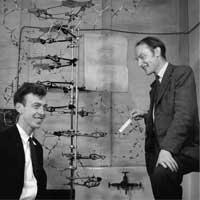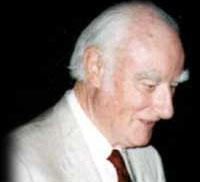Double propeller half a century
2003/04/01 Carton Virto, Eider - Elhuyar Zientzia | Roa Zubia, Guillermo - Elhuyar Zientzia Iturria: Elhuyar aldizkaria
What is the reason to know the machinery of life? Curiosity? Control? Can I create new living beings? What are the main causes of healing? To suffer as little as possible? Lengthen life? Why is long life better than short? Why do we flee from death? For fear? To what extent does the human being have the right to transform the cycle of life?
These questions have come from the origins of biology. Perhaps earlier. However, DNA research has been resurrected and updated. But it is not an instant account. To see where this update comes from, just pull the investigation. Until when? At least until the microscope became a common tool for biologists.
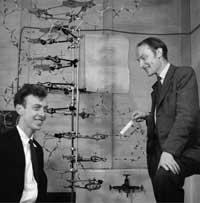
The cells were very interesting for many reasons. For example, they keep the secret of inheritance: all cells are copies of other previous cells. The cells create new cells. How is it possible? The microscope did not respond. They carried out many experiments to seek response. And little by little the results guided the research towards the cell nucleus.
However, the inheritance is not just copying cells. In addition, through inheritance, the characteristics of the reproducing being are repeated in the being that is born. From this idea, in 1906, Wilhem biologist Ludwig Johannsen invented the word gene. The gene was a "something" that transmits a characteristic, but XX. At the beginning of the twentieth century scientists had no idea what this 'something' was like and what it is made of.
What is the goal?
If it is observed well, within the nucleus of the cells a mixture of matter is seen. And if we catch the cell while copying, it is clearly seen that the core of confusion is filaments. In 1888, the German Wilhem von Waldeyer proposed the word chromosome to designate the filaments.
Waldeyer could not see the appearance of these filaments; today we know how to separate the components of this mixture and that the chromosomes have X-shape. But for most scientists of the time, the appearance of chromosomes was not important. On the contrary, they wanted to know if chromosomes and genes were the same.
Chromosomes and genes are not the same. However, there are reasons to think otherwise. In short, both chromosomes and genes are 'repeated' in each cell. Why won't the information of a characteristic being be a chromosome? Walter S. The cytoologist Sutton was very clear that man inherited thousands of qualities and only has 23 different chromosomes. There was no doubt. On each chromosome many genes were needed. So, how are genes physically?
Pumps and bacteria
The structure of the DNA molecule is the answer to this question. Now we know it. But by 1920 the scientists had nothing clear. In the nucleus, along with DNA, there were proteins, but it was not known what their function was.
DNA or proteins? Who determines the characteristics of the living being? Without any other type of analysis, proteins appear to be much more complex and interesting molecules than DNA.
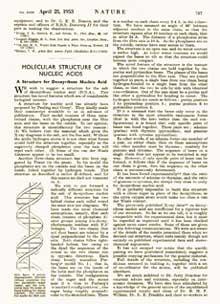
In short, the basic parts needed to form a protein have a much greater variety than those needed to form DNA. There are twenty amino acids that can intervene in the structure of proteins, while DNA uses only four nucleotides. (This makes the structure of DNA not vary from one molecule to another and the changes between proteins are enormous. However, biologists then did not know the structure of these molecules.) However, in the 1930s it was not possible to answer this question. It is no wonder.
To investigate what is within the core, many resources are needed, and at that time scientists did not have the right equipment and did not know the basic concepts to know. Perhaps it was too early for biology. Among other things, he needed physics. For example, it should be remembered that X-ray diffraction was fundamental for the study of biomoleculae structures.
Physics predominated in science. This is what historians of science think. The atom, electromagnetic radiation, relativity, quantum mechanics… were emerging new physical concepts that altered science. The first half of the century was for physics, science was innovative for an innovative society and was willing, among other things, to apply it in totally innovative wars. After the atomic bomb explosion in Hiroshima, many scientists were frightened by the atom's capacity, but could no longer retreat.
Structure and prize
But the war was not sterile from a biological point of view. In 1944, Americans Oswald Avery, Colin McLeod and Maclyn McCarty took an important step: They saw that DNA was the key to inheritance.
These biologists worked with tyres. Two types of pneumococci were used in the laboratory, one with a roughness surface and one with a soft surface cover. In the scientists' experiment, the DNA is extracted from some "soft" of dead pneumococcus and injected into live wrinkles. Over time, the latter developed a smooth cover, that is, even though they come from dead organisms, DNA could transmit characteristics.
This discovery prompted DNA research. In addition, at the end of the war, European researchers significantly improved their working conditions. In this situation, DNA research was very tempting, since being such an important molecule, probably the one that clarified the structure would win the Nobel Prize.
The English James Watson, Francis Crick, Maurice Wilkins and Rosalind Franklin participated in this research. It is a dark story that has been the subject of many writings (see Elhuyar Zientzia eta Teknika 185, 20-23). Page. ).
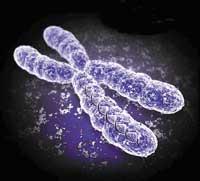
On February 28, 1953, Watson and Crick proposed the double-helix model, which was published in issue 25 of April of the journal Nature together with other investigations. For this discovery they were awarded the 1962 Nobel Prize in Medicine with Maurice Wilkins. Rosalind Franklin had already died.
DNA, elegant structure
They have turned fifty years since Watson and Crick released the structure of DNA and the world has wanted to celebrate it. These days the definition of the structure of DNA will be heard frequently. that has been one of the scientific milestones of the twentieth century. However, that same year, in 1953, Max Perutz laid the foundation for clarifying the structure of proteins; and in 1955, Sanger first read the amino acid sequence of a protein.
Are they less important than the double helix? It is clear that no. So, why so much imbalance in the celebrations? It seems that the key is in elegance.
The double helix is an elegant structure that has become the icon of modern science. The artists also want it. But 50 years ago it wasn't.
In the years following the discovery, the double helix received no great attention from the scientists. In journals Science and Nature until 1960, for example, few articles that spoke of DNA referred to the structure of Watson and Crick. Curious because then much was investigated about DNA.
However, the relationship between DNA and proteins was not very clear and, above all, they did not know that the production orders were stored in DNA. For Robert Olby, this is why so few cases were given to the structure of DNA. Olby Pittsburg, professor emeritus of Philosophy and History of Science at the University, has collected the aforementioned data.
In the early 1950s, it was known that DNA was the molecule of inheritance. They also knew it is along with proteins in the nucleus, but not all the pieces were joined. They still did not understand that the indicators of the characteristics that go from generation to generation are proteins. Therefore, DNA and proteins were studied in two different lines of research.
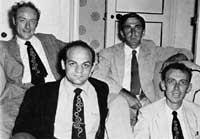
The great step towards the unification of lines was given by astronomer George Gamow. In the last years of his life he began to investigate DNA and proposed a theory on how DNA encoded information. In his opinion, this code was formed by orders of elaboration of proteins. But what was the specific code?
DNA linguists
The DNA was composed of four letters that should be translated into another language of 20 letters, that of proteins. What was the correct combination? The letters of DNA taken from two to two were sixteen choices, therefore insufficient, and three to 64. It could be. But, if so, what trio corresponded to each amino acid? Was only one or more worth?
Gamow's proposal aroused great interest among scientists and created a club with twenty scientists to foster communication and friendship and propose and discuss possible codes: Club tie RNA. It was a special club. Each member had a tie with the structure of the RNA and a needle with the abbreviation of the name of an amino acid. This abbreviation was the nickname of his companion. Among others, Watson and Crick participated in this club. It was 1954 and things began to change. Many protein lovers dedicated themselves more to looking at DNA.
Three years later, in 1957, Crick at the Symposium of the Association of Experimental Biology unveiled the “Main Dogma”: From DNA to RNA, to protein. Four years later they understood the first letters of genetic language.
In a book he acknowledged that he used the word dogma to draw attention, not knowing what it really meant. Dogma is an affirmation that is considered a basic truth, whether or not evidence. But in this case it cannot be said that Crick has not been tested. Today we all believe in it.
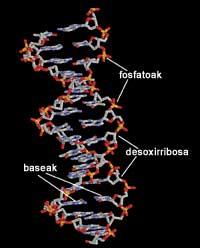
The propellers are characteristics of biology, they are stable structures so their support function is simple. However, the case of DNA is special: it is a double helix that does not perform structural functions; it is the refuge of information.
The two propellers are wound together, in the opposite direction, that is, placing "up" the repetitive sequence of the units of phosphate sugars of a filament, that of the other strand is ordered "down".
It is a very elegant, simple and effective structure: the deoxyribose sugar units and the phosphate groups are located on the outside of the propeller, while inside are the bases to keep together both filaments. DNA information is based on the sequence of these bases.
Human cells have 23 pairs of chromosomes, half of parents, and half of the mother. The eggs and sperm only 23. And these chromosomes are not pure. Two eggs are formed from a cell of 23 pairs of chromosomes, but before distribution the process called recombination occurs. Between pairs of chromosomes with the same information, the parts of DNA are exchanged, somehow the information of the father and mother is mixed and then the division occurs. Thus, from generation to generation, the same genetic information is not transmitted. In 1972, the same was done in the laboratory. Researchers at the University of Standford created a DNA molecule of genetic material from both viruses. In 1970 enzyme bacteria were identified as capable of knowing and cutting certain sequences of the DNA chain and, two years later, Paul Berg isolated one of them to cut DNA. He cut the DNA of the SV40 monkey virus that produces cancer and unified it with a virus that contaminates bacteria through other enzymes. The next step is that molecule of DNA E. Coli was grafted into the bacteria, but the one who got it scared or left the experiment there. That same year, together with other researchers, he published a letter in the journal Science, in which he proposes to suspend for a year research on the recombination of DNA. But it was not successful. The first genetically modified organism was born at Stanford University in 1973. |
The information contained in the genetic material can be read 'manually', but the smallest bacterium also has many data. The amount of data is a serious problem in both collection, storage, and analysis.
The solution to this problem came in 1986. The American Leroy Hood developed the first machine to automatically read the DNA sequence. This meant a great boost to the projects created to know the genes.
The greatest echo of these projects is related to the complete sequencing of the human genome. It is a gigantic project of access and analysis of the information contained in the 23 chromosomes of the human being, supposedly finished.
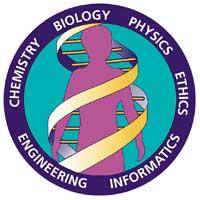
The methodology that began using the PNS was slow and the first idea was to finish the work for fifteen years, although advances allowed to reduce the deadline and announced that it would end in 2003.
In 1998 they learned that a private company launched the same project, the company Celera Genomics Corporation. This company wanted to use a new and faster methodology. Then, the GNP changed the strategy by trying to somehow accelerate the process. Instead of performing the work with great precision, a draft of the genome map will be drawn up within a shorter period. From this draft a concrete work would be undertaken.
Celera Genomics had another strategy: to break the entire genome and read the code of all the pieces. Before fully immersing himself in the project, Celera Genomics confirmed that the methodology was faster using genomes from small organisms.
On 13 February 2001, the most prestigious scientific journals in the world, Nature and Science, published two special issues for the presentation of two drafts of the human genome, the organization of the International Human Genome Project and the private company Celera Genomics, respectively.


Gai honi buruzko eduki gehiago
Elhuyarrek garatutako teknologia




